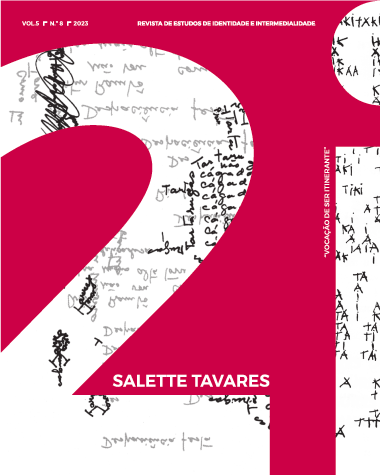The reinvention of poem in Salette Tavares
DOI:
https://doi.org/10.21814/2i.4863Keywords:
Salette Tavares, Poetry and reinvention, Game and appropriationAbstract
In this paper, we discuss the poetry of Salette Tavares under the sign of invention and play. Through the play of language in the verbal and non-verbal planes, Tavares renews the matter that gravitates immersed in the memory of childhood or in the free experience with the languages and objects that surround us, leading us to new aesthetic experiences. The poet reinvents the poem, which itself becomes a critical object in dialogue with other things in the world. In her poetry and in her texts, the need to re-situate writing in the context of a "society of objects" seems imperative. There is a friction between the gesture of undoing and reconstructing the object as critical writing. Reflecting on writing is part of this process, as in “Brincade iras”, or in Lex Icon. In the latter's poems, we can glimpse the discovery of things through words, and vice versa. We will provide other examples and read other works throughout the text. However, it is important to note the connection between his work and the experience of things. In this way, we intend to demonstrate that her poetics is made through the problematization of language and its re-signification.
Downloads
References
Campos, A. de & Plaza, J. (2009). Reduchamp. Texto de Augusto de Campos e iconogramas de Júlio Plaza. São Paulo: Annablume.
Castro, E. M. de M e. (1995). Visões do espelho cego. In Voos da Fénix Crítica (pp. 177-184). Lisboa: Ed. Cosmos.
_____ (1981). Ver-ter-ser. In E. M. de M. e Castro & A. Hatherly, Po-ex: textos teóricos e documentos da poesia experimental portuguesa (pp. 153-165). Lisboa: Moraes Editores.
Dorfles, G. (2020). Prefácio. In S. Tavares. Lex Icon (pp. 5-20). Lisboa: Tigre de Papel.
Dumas, C. (2019) Prefácio. In S. Tavares, Irrar (pp. 5-9). Lisboa: Tigre de Papel.
Hatherly, A. (2006). Quase-Tisana no RL-24-X. In 463 Tisanas (pp. 173-174). Lisboa: Quimera Editores.
Iser, W. (2002), O jogo do texto. In L. Costa Lima (Coord. e trad.), A Literatura e o Leitor: textos de estética da recepção (pp. 105-118). Rio de Janeiro: Paz e Terra.
Moles, A. A. (1972). Objeto e comunicação. In A. A. Moles, J. Baudrillard, P. Boudon, H. V. Lier, E. Wahl, Semiologia dos Objetos – seleção de ensaios da Revista “Communications” (pp. 9-41), trad. Luiz Costa Lima. Petrópolis, RJ: Vozes.
Portela, M. (2019). Desmontar o mundo como um brinquedo. In S. Tavares, O Kágado, seguido de Baile Mecânico e Animatógrafo (pp. 7-21). Lisboa: Tigre de Papel.
Rosa, A. R. (1991). O poema aberto e nu. In A Parede Azul – Estudos sobre poesia e artes plásticas ( pp. 13-14). Lisboa: Editorial Caminho.
Tavares, S. (1979). Introdução. In Brincar (pp. 7-11). Lisboa: Galeria Quadrum, 1979. Consultado em https://www.poex.net/images/stories/salettetavares/textos/salettetavares_brincar_intro_catalogo.pdf.
_____ (1995). Carta de Salette Tavares para Ana Hatherly. In Poesia Gráfica (pp. 16-19). Lisboa: Casa Fernando Pessoa.
_____ (2020). Lex Icon. Lisboa: Tigre de Papel.
Downloads
Published
How to Cite
Issue
Section
License
Copyright (c) 2023 Rogério Barbosa da Silva

This work is licensed under a Creative Commons Attribution-NonCommercial 4.0 International License.


.jpg)










